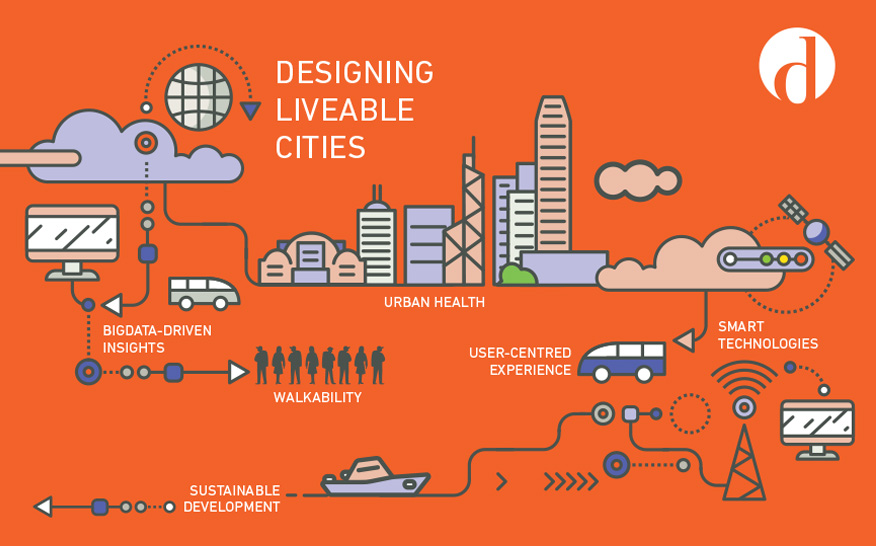DMatters July 2018 Issue

Reshaping Urban Mobility Through Good Design
In many cities, the collective daily commute time could rack up to millions of hours. We evidently need to revolutionise the way we travel to save us time, free up urban space, reduce energy consumption and ultimately, create economic value. A pleasant and efficient mobility experience is essential to a city’s liveability, making it accessible and welcoming to locals and tourists alike.
Autonomous vehicles, real-time data analytics, ride sharing apps… a new generation of intelligent transport technologies are currently on the rise. Whether for public transport systems or individual point-to-point car journeys, data is playing a pivotal role in boosting efficiency. In the Knowledge of Design Week (KODW) held in Hong Kong last month, leading-edge designers and innovators have collectively presented eye-opening scenarios of the future of mobility.
Carlo Ratti from the Senseable City Lab at MIT showed us how open data and smart city design can make urban transport extremely energy-efficient. He set the tone with 4 figures, “Cities represent only 2% of the surface of the planet, but they have 50% of the world’s population, 75% of the energy consumption and 80% of the CO2 emissions. If we can do something to make our cities a little more sustainable, it can be a big deal globally.” Their “Minimum Fleet Network” model developed an algorithm to mastermind the most efficient cab ride connections that can satisfy the mobility demand of Manhattan with only 60% of the current amount of cabs. After all, among the 13,000 taxis driving through the area every day, they had found that they are vacant 40% of the time when they circle around looking for passengers. Adding self-driving cars into the picture, they can even theoretically model how to move Manhattan using only 50% of the 275,000 running cars of today. The lab is also extending its autonomous technology to water transport with their “Roboat” floating modules, recently being put into test in Amsterdam.
Pratap Bose, the Head of Design at Tata Motors, sees the future of on-demand car-sharing solutions for India’s burgeoning youth population — presently, around half of the country, or 650 million people, are aged below 25. Such a massive young demographic with strong consumption power and digital aspiration makes the Indian market more innovative than other countries with an ageing population. To unleash the full potential of smart vehicles, his team is creating the digital infrastructure to couple with their environmental-friendly smart car. With the car-sharing app at their fingertips, users can request for an autonomous car which is programmed to platoon to maximise road usage. Without the need to drive, they can be more productive en route. As the ride is completed, the self-driving car is freed up to pick up other passengers instead of taking up parking space idly. In other words, heavy traffic would be alleviated and we would no longer need to own a car or learn to drive to enjoy the freedom of the road.
As you might have guessed, data-driven innovations are not limited to individual point-to-point journeys but also public transport. Gene Soo and his team at Citymapper are improving our public transport experience by analysing real-time travel data to find out the best possible and cost efficient routes. “We use location-aware devices, available open data and user-centred design to generate the exact transport guidance that people need.” The app has been a huge success in letting people grasp all that they need to know to navigate through megacities like London and Hong Kong. They pioneer the usage of data in public transport in two ways. First, they turn transport data like bus timetables into machine-readable formats and let computers do the hard yards. In Hong Kong, the app computes the existing 20,000 fare combinations and concession rules to instantly identify the cheapest route. They also adopt widely used data formats and open up the datasets to startups, companies and anyone, hence championing innovations across the industry. The app is extending its service into the real world with its all-new “Smart Ride” initiative in London which combines carpooling and on-demand ride services.
The new generation of transport goes way beyond the technology frenzy. It is anchored on a pleasant travel experience as well. We are expecting the more efficient use of urban space and energy, an improved city environment, as well as better connections between people. But let’s not forget Markus Shaw and those who are also contributing to the initiative of making the city more walkable, such as the “Walk DVRC” initiative which endeavours to pedestrianise part of our Des Voeux Road Central. Soon enough, Elon Musk’s "Hyperloop One" and Uber’s aerial rides “uberAIR” will be a reality. We can’t wait to see how all these innovations will game change our life from the ground up.
This issue of DMatters is filled with different voices from the design community. First, we will get to know 4 fresh faces in our fashion incubation programme (FIP) through their design journeys and career ambitions. Up next we will look back at our pilot design exchange programme DXHK from the lens of the participating designers, who had fruitful exchange experiences in Melbourne and Bangkok. Capping off is a chat with DFA Awards judges to learn about the criteria of award-winning designs as the judging process is now under way.
Further reading
More about Knowledge of Design Week (KODW) 2018 “Design for Liveability”
www.kodw.org
“How many taxis does a city need?” — more about MIT Senseable City Lab’s Minimum Fleet Network
https://news.mit.edu/2018/minimum-vehicle-fleet-rider-demand-0523
“The Responsive Network” — Citymapper on Smart Ride
https://medium.com/citymapper/the-responsive-network-part-3-3-f9d8394d84f3
Click here to read the full issue of DMatters July 2018.